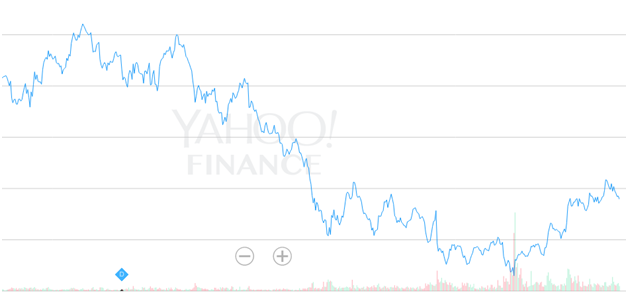About a year ago, the financial world witnessed another “Lehman moment”. It was the “near collapse” of Deutsche Bank (DB). The financial press quickly pointed out the main reason for DB’s plunging stock price. John Glover wrote
Yield-starved investors bought $102 billion of the contingent convertible bonds, securities created to help troubled banks hang onto cash in times of stress by skipping coupon payments without defaulting and converting the debt to equity or writing it down. Even though neither of those has yet happened, investors are already feeling the pain, as yields on Deutsche Bank AG’s 4.6 billion euros ($5.2 billion) of CoCos have soared and its shares have plummeted.

Deutsche Bank share price as at Feb 10, 2017. Source: Yahoo Finance
However, what exactly is a contingent convertible bond ?
According to Wikipedia:
A contingent convertible bond is defined with two elements: the trigger and the conversion rate. While the trigger is the pre-specified event causing the conversion process, the conversion rate is the actual rate at which debt is swapped for equity. The trigger, which can be bank specific, systemic, or dual, has to be defined in a way ensuring automatic and inviolable conversion. A possibility of a dynamic sequence exists—conversion occurs at different pre-specified thresholds of the trigger event. Since the trigger can be subject to accounting or market manipulation, a commonly used measure has been the market’s measure of bank’s solvency. The design of the trigger and the conversion rate are critical in the instrument’s effectiveness
A CoCo bond might appear to be an attractive investment, but from the convertible bond pricing model point of view, valuing such a contingent conversion feature is far from trivial. As discussed in this post, pricing even a simple conversion feature would require serious mathematical modeling and programming efforts.
Usually the 20/30 contingent conversion can be modeled somewhat explicitly on the PDE lattice by introducing an extra state variable which tracks whether the condition was satisfied in the previous monitoring quarter. However, the soft call feature is often more material as it is in the interest of the issuer to call the bond as soon as the value equals the call price (plus accrued interest).
Readers who would like to learn more about the mathematical aspects of pricing a contingent convertible bond can start with the following articles:
Valuing convertible bonds with 20-of-30 soft call provision
Back to the Future: An Approximate Solution for N Out of M Soft-Call Option
Convertible Bond Valuation: 20 Out Of 30 Day Soft-call
Further questions
What's your question? Ask it in the discussion forum
Have an answer to the questions below? Post it here or in the forum

A proposal to give up search and user data faces long odds but still raises the stakes for the company.

After US federal prosecutors charged Gautam Adani and several associates with fraud, media coverage in India has ranged from dryly factual to over-the-top in its defensiveness, revealing a divide over how to appraise bribery accusations against one of the nation’s richest businessmen.

As artificial wave pools proliferate around the world, surf park developers aim to go green to counter criticism over energy and water use.

